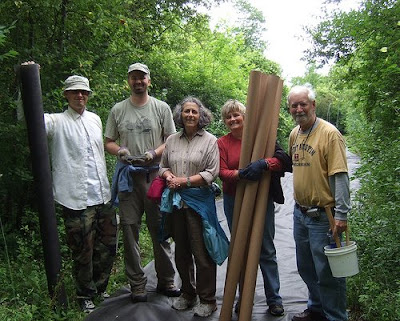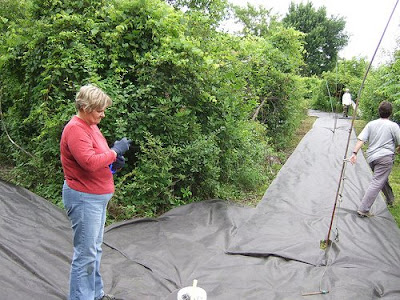The spring 2009 survey season took place from 9 April through 9 June. There were surveys on each morning for the first 57 days, and two of the last four days. On campus,
140 species were recorded (another 17 were recorded in Dearborn off-campus). This is nearly 6% greater than the previous five-year average of 133 species. The peak calendar week was 17 through 23 May with 95 species, and the peak day was 18 May with 86 species.
WeatherIn contrast to some recent spring seasons, spring 2009 seemed fairly "normal." The
National Weather Service noted (
PDF) that in Detroit, average tempertures for March through May were just a degree above normal, while rainfall was nearly 3.5 inches above normal. Most of the precipitation was in April; May was slightly below normal. Most noticable to me was the steady progression of vegetation leaf-out and blooming that was not interrupted by extreme cold (as in 2007) or abbreviated by extreme heat. Insect emergence and growth seemed normal. Although anecdotal, it appeared to me that food resources for migrants were adequate to abundant.
Arrival datesWhile I track arrival dates for all migrant species, I especially focus on 43 regularly-occurring and conspicuous migrants. Of those,
three species arrived earlier than had been previously recorded for Dearborn: Ruby-throated Hummingbird on 1 May (previous date, 1 May), American Redstart on 30 April (previously 1 May), and Indigo Bunting on 28 April (previously 29 April).
Two species tied their record early arrival date: Tennessee Warbler on 29 April, and Black-throated Blue Warbler on 30 April.
Extremes are interesting, but deviation from a more typical arrival date is probably a more accurate depiction of any shift in migratory phenology. I have 14 to 16 years of spring arrival dates for nearly all of these 43 species. There are a number of ways to calculate central tendency (or the "expected" middle value of a data set). For simplicity's sake in this example, I calculated the arithmetic mean, or average arrival date for each species to compare to this year's arrival dates. For the 43 species:
- Four (9%) arrived on their average arrival date.
- Seven (16%) arrived later than average (the average for those species only was 2.4 days later)
- Thirty-two (74%) arrived earlier than their average arrival date (for those species, the average was 5 days earlier).
- For all 43 species, arrival time averaged 3.3 days earlier than "usual."
Most instructive would be an analysis of any shift in peak arrival periods, or the dates in which different percentiles of each species peak (e.g., the date each year in which the first 20% of Ovenbirds of the season have been recorded). I am in the process of computerizing all of our spring survey data back to 1994. Soon, I will have completed the input of 10 years of data, and will begin some preliminary analyses.
HighlightsThere were a number of species represented by only one to a few sightings. Often this is due to a lack of habitat on campus so that visits or flyovers are rare (
Common Loon, American Bittern, Grasshopper Sparrow). A few are just rather cryptic and hard to see, hear, or identify (
Philadelphia Vireo, Connecticut Warbler, Lincoln's Sparrow). Some species occur annually or nearly so, but are at the edge of their range in southern lower Michigan, and are often considered "good birds." This year, they were
Hooded Warbler (3 birds) and
Summer Tanager (3 birds).
Prothonotary Warbler is a species that does occur in the region but only locally, and 2 different birds were recorded this season. Falling somewhere between lack-of-habitat and actually-rare was a single
Grasshopper Sparrow recorded on 18 April.
Species that in past years have typically been more common but were only seen once or a few times this spring were
Red-headed Woodpecker, Acadian Flycatcher, Golden-winged Warbler, and
Rusty Blackbird. All of these species are also declining regionally, if not range-wide.
You can look over the summaries of each week here at Net Results for more highlights.
Missing on campus, and with only one report in the city this spring, was
Orchard Oriole, normally seen every year. The most surprising miss this spring was
Willow Flycatcher. This is a typically common species, but was not definitively recorded this year. It is likely they were actually present, as a number of non-singing
Empidonax flycatchers were seen, but without hearing them they can't be distinguished from the similar
Alder Flycatcher. Overalll, Empids in general seemed scarce. The three most common species (Least, Willow, and Alder) were down 43% from last year. Their numbers were roughly the same as the previous 5-year mean, but a longer look-back period would be most useful and these calculations have not been adjusted for effort.
The most numerous species by number of individuals counted was
Brown-headed Cowbird, a species which has made monumental increases the last few years. Four or five years ago, we'd expect to count around 200 in a spring season. This jumped to over 300 the next couple of years, then over 1000 last year to 1671 this year. I suspect that overwinter survival in the city has something to do with this, as numbers have been increasing recently due to the presence of the
sunflower fields around Dearborn.
Other numerous species were
American Robin and
Northern Cardinal, also with over 1000 tallied.
Yellow-rumped Warbler came in fourth place at 946, while
American Goldfinch rounded out the top five at nearly 900 counted.
In general, numbers seemed to be improved from the last couple of years, but peak numbers of warblers, for instance, were not impressive. Twenty-nine warbler species were recorded, but only 9 species had peak numbers over 10 individuals and all of those were 20 or fewer individuals except for Yellow-rumped Warbler, which had a high count of 129 on 30 April.
More interesting trends will no doubt be revealed once I get all the years of survey data computerized and dumped into a stats program. I'll also be able to produce some fairly detailed charts on peak migratory times for many species.
Many thanks to Darrin O'Brien, Greg Norwood, Jim Fowler, and Mike O'Leary who assisted with surveys this spring.
I'll be working on data input and some other projects, mostly in front of the computer, over the summer and will be posting periodic updates here. Then fall banding kicks off in mid-August!
 The weather wasn't bad this week, so I did get to band every day. A drenching downpour cut things short on Thursday, as did gusty winds today. Things started out rather slowly, with mostly resident birds being captured. Of the 18 species banded, only two do not nest on site: Veery (one banded on Aug 17) and American Redstart (one banded on Aug 18).
The weather wasn't bad this week, so I did get to band every day. A drenching downpour cut things short on Thursday, as did gusty winds today. Things started out rather slowly, with mostly resident birds being captured. Of the 18 species banded, only two do not nest on site: Veery (one banded on Aug 17) and American Redstart (one banded on Aug 18). The other notable species was Baltimore Oriole. Orioles are also common here, but they are early migrants. Some autumns, I catch none at all. My fall average is less than 3 birds a season, and my record is 14. I've tied that record already, with over half of them being captured yesterday -- six were in one net!
The other notable species was Baltimore Oriole. Orioles are also common here, but they are early migrants. Some autumns, I catch none at all. My fall average is less than 3 birds a season, and my record is 14. I've tied that record already, with over half of them being captured yesterday -- six were in one net!







